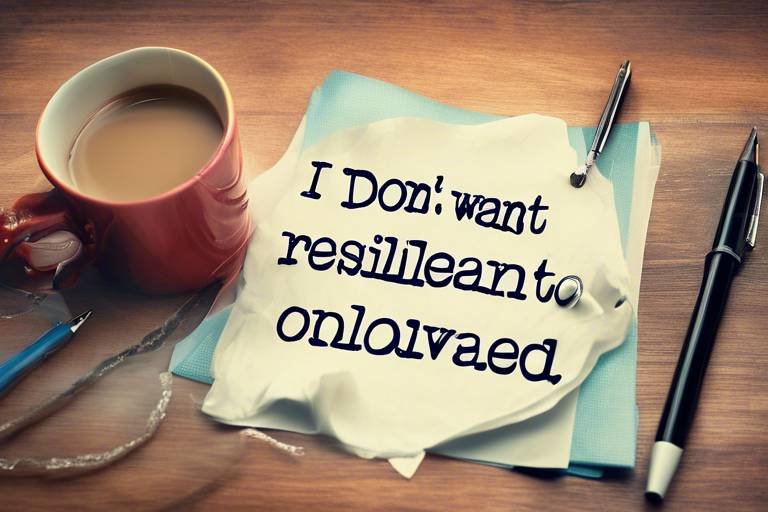Does Confidence Affect Your Performance at Work?
In today's fast-paced work environment, the question of whether confidence plays a pivotal role in workplace performance is more relevant than ever. Have you ever noticed how some individuals seem to glide through their tasks with ease, while others struggle, even when their skills are comparable? The answer often lies in the level of self-assurance they possess. Confidence can act as a powerful catalyst, propelling individuals toward greater productivity, clearer decision-making, and heightened job satisfaction. But what exactly is the connection between confidence and performance? Let's dive deeper into this fascinating relationship and uncover how fostering confidence can lead to a more dynamic and effective workplace.
Confidence is frequently regarded as the secret sauce to professional success. When you believe in your abilities, you’re more likely to pursue opportunities that come your way. Think of confidence as a magnet that attracts success; it pulls in chances for advancement, collaboration, and innovation. For instance, a confident employee is more likely to volunteer for challenging projects, share ideas during meetings, and take initiative, all of which can lead to career growth and personal development. On the flip side, a lack of confidence can create a barrier, preventing talented individuals from showcasing their skills and contributions. In essence, self-belief not only enhances personal performance but also enriches the overall workplace culture.
Have you ever found yourself hesitating to make a decision, only to see someone else jump in with confidence? Confidence significantly influences how we make choices. A confident mindset enables quicker and more effective decision-making, allowing individuals to trust their instincts and expertise. This is particularly crucial in high-stakes situations where time is of the essence. However, it’s important to tread carefully; while confidence can lead to sound decisions, it can also result in the pitfalls of overconfidence. When individuals overestimate their abilities, they may overlook critical details or ignore valuable feedback, leading to poor outcomes. Striking a balance between confidence and caution is essential for optimal decision-making.
Risk-taking is often intertwined with confidence. When individuals believe in their capabilities, they are more inclined to embrace challenges and venture into uncharted territory. Imagine a tightrope walker; the higher their confidence, the more daring their performance. In the workplace, this translates to a willingness to innovate, propose new ideas, and tackle complex problems. Confident individuals are generally more open to taking calculated risks, which can lead to breakthroughs and advancements. However, it's crucial to remember that not all risks yield positive results, and understanding the context is key to making informed choices.
Finding the sweet spot between confidence and caution is vital. While confidence can drive success, unchecked self-assurance may lead to reckless decision-making. To maintain this balance, consider implementing strategies such as seeking feedback from colleagues, conducting thorough research before making decisions, and being open to alternative viewpoints. These practices can help ensure that confidence enhances, rather than hinders, performance.
While confidence is generally beneficial, overconfidence can be a double-edged sword. Individuals who are excessively self-assured may dismiss potential risks and fail to recognize their limitations. This can lead to significant mistakes, missed opportunities, and ultimately, a decline in performance. It's essential to cultivate a realistic self-assessment and remain aware of areas for improvement. Acknowledging that there’s always room for growth can help mitigate the dangers of overconfidence.
So, how can organizations foster confidence among their employees? Building a culture of confidence requires intentional strategies. Training programs that focus on skill development, mentorship opportunities that pair less experienced employees with seasoned professionals, and regular feedback sessions can significantly enhance self-assurance. Furthermore, creating an environment where employees feel safe to express their ideas and take risks can also bolster confidence levels. Remember, a confident workforce is not just beneficial for individuals; it enhances team dynamics and contributes to overall organizational success.
The impact of individual confidence extends beyond personal performance; it significantly affects team dynamics as well. Confident team members can inspire others, fostering a collaborative atmosphere that enhances group performance. When team members feel assured in their abilities, they are more likely to communicate openly, share ideas, and support one another. This synergy can lead to improved morale and a more productive work environment. In contrast, a lack of confidence can create tension and hinder collaboration, which may ultimately stifle progress.
Creating a workplace that promotes confidence is crucial for optimal team dynamics. Best practices include recognizing individual contributions, celebrating achievements, and encouraging open dialogue among team members. When employees feel valued and supported, their confidence flourishes, leading to a more engaged and motivated workforce.
Lastly, recognition plays a vital role in reinforcing confidence. Acknowledging confident behaviors not only motivates employees but also sets a precedent for others to follow. Consider implementing reward systems that celebrate risk-taking, innovative ideas, and collaborative efforts. This not only boosts individual confidence but also cultivates a culture of excellence throughout the organization.
- How can I improve my confidence at work? Start by setting small, achievable goals and gradually take on more challenging tasks. Seek feedback and engage in self-reflection.
- What are the signs of overconfidence? Signs include dismissing advice, taking excessive risks, and failing to prepare adequately for tasks.
- Can confidence be learned? Absolutely! Confidence can be developed through experience, practice, and support from peers and mentors.
- How does team confidence affect overall performance? A confident team is more likely to communicate effectively, support each other, and achieve collective goals.

The Role of Confidence in Professional Success
Confidence is often seen as a key ingredient for success in any professional setting. When individuals believe in their abilities, they are more likely to take initiative, pursue opportunities, and achieve their goals. Think of confidence as the fuel that powers the engine of professional achievement. Without it, even the most talented individuals may find themselves stuck in neutral, unable to accelerate toward their aspirations.
One of the most striking ways confidence impacts professional success is through its influence on opportunity recognition. Confident individuals are more inclined to seek out new challenges and opportunities, whether it’s a promotion, a new project, or a chance to showcase their skills. This proactive approach can lead to remarkable career advancements. In contrast, those who lack confidence may hesitate to step outside their comfort zones, potentially missing out on valuable opportunities.
Moreover, confidence fosters a positive mindset, which is crucial for overcoming setbacks and challenges. When faced with obstacles, confident individuals are more likely to view these hurdles as learning experiences rather than insurmountable barriers. This resilience not only enhances personal growth but also contributes to a more dynamic and innovative workplace. In fact, research has shown that teams with confident members tend to be more productive and creative, as they are willing to share ideas and take risks.
However, the relationship between confidence and success isn't just about individual performance. It also plays a significant role in how one interacts with others. Confident individuals often inspire those around them, creating a ripple effect that can elevate team morale and performance. For instance, when a leader displays confidence, it can instill a sense of assurance in their team, encouraging them to perform at their best. This leads to a more collaborative and motivated work environment.
To illustrate the impact of confidence on professional success, consider the following table:
| Aspect | Confident Individuals | Less Confident Individuals |
|---|---|---|
| Opportunity Recognition | Actively seek and embrace new opportunities | Often hesitant to pursue new challenges |
| Response to Setbacks | View challenges as learning experiences | See obstacles as barriers to success |
| Team Influence | Inspire and motivate others | May struggle to influence team dynamics |
In summary, confidence is not merely a personal trait; it is a powerful driver of professional success. By cultivating self-belief, individuals can unlock their potential, seize opportunities, and inspire those around them. As we continue to explore the various dimensions of confidence in the workplace, it becomes clear that fostering this essential quality can lead to a more engaged and productive workforce.
- How can I improve my confidence at work? Start by setting small, achievable goals and celebrating your successes. Seek feedback and engage in continuous learning to build your skills.
- What role does confidence play in leadership? Confidence is crucial for leaders as it helps them make decisive choices, inspire their teams, and navigate challenges effectively.
- Can overconfidence be harmful? Yes, while confidence is important, overconfidence can lead to poor decision-making and increased risk-taking, which may have negative consequences.

Impact of Confidence on Decision-Making
Confidence plays a pivotal role in how we make decisions, often acting as a guiding star in the complex landscape of workplace choices. When individuals possess a high level of self-assurance, they are more inclined to trust their instincts and take decisive action. This can lead to quicker resolutions in high-pressure situations, where hesitation might otherwise result in missed opportunities. Think of it like driving a car; when you’re confident in your ability to navigate the road, you’re more likely to make smooth and timely turns. On the other hand, if you're unsure, you might second-guess every move, which can lead to accidents or getting lost.
Moreover, confidence can enhance the quality of decisions made. Research suggests that confident individuals often approach problems with a positive mindset, which can result in more creative and innovative solutions. They are less likely to be bogged down by the fear of failure, allowing them to explore unconventional options that others might shy away from. However, this doesn’t mean that confidence is a blanket solution to decision-making; it’s crucial to recognize the fine line between confidence and overconfidence.
Overconfidence can cloud judgment and lead to poor decisions. For instance, an overly confident employee might underestimate risks or overlook critical details, thinking they have everything under control. This is akin to a gambler who believes they can’t lose, only to face a harsh reality when the odds turn against them. To illustrate this point, let’s consider a simple table that outlines the differences between confidence and overconfidence:
| Aspect | Confidence | Overconfidence |
|---|---|---|
| Decision-Making | Informed and balanced | Impulsive and reckless |
| Risk Assessment | Realistic understanding of risks | Underestimates potential pitfalls |
| Outcome Evaluation | Willing to learn from mistakes | Blames external factors for failures |
Finding the right balance is essential. A confident decision-maker should not only trust their abilities but also remain open to feedback and new information. This balance allows for a more comprehensive view of the situation at hand, leading to better outcomes. Additionally, fostering an environment where team members feel empowered to express their opinions can enhance collective decision-making. After all, collaboration often breeds creativity, and a confident team is more likely to generate innovative ideas.
In conclusion, while confidence significantly impacts decision-making, it is vital to strike a balance. Encouraging a culture of confidence, while also promoting caution and reflection, can lead to a more effective and dynamic workplace. As we navigate the complexities of professional life, let’s remember that confidence should be our ally, not our adversary.
- How can I improve my confidence at work? Engaging in training programs, seeking mentorship, and setting achievable goals can help build your confidence over time.
- What are the signs of overconfidence? Signs include ignoring feedback, making impulsive decisions, and consistently underestimating risks.
- Can confidence be learned? Absolutely! With practice, self-reflection, and a supportive environment, anyone can boost their confidence levels.
- How does team confidence impact overall performance? Confident teams tend to collaborate better, communicate more effectively, and are more innovative in problem-solving.

Confidence and Risk-Taking
When we think about confidence, one of the first things that comes to mind is its undeniable link to risk-taking. Imagine a tightrope walker, balancing high above the ground. It’s not just their physical skills that keep them from falling; it’s their confidence in their abilities that allows them to take that leap, literally and metaphorically. In the workplace, this analogy holds true as well. A confident individual is more likely to embrace challenges and take calculated risks that can lead to innovation and growth.
Why does confidence fuel risk-taking? Well, it boils down to a few key factors:
- Self-Belief: Confidence instills a sense of self-belief, making individuals feel capable of overcoming obstacles.
- Positive Outlook: Confident people tend to have a more positive outlook on potential outcomes, viewing challenges as opportunities rather than threats.
- Resilience: When faced with setbacks, confident individuals are more likely to bounce back and try again, which is essential for taking risks.
However, it’s important to note that not all risk-taking is created equal. There’s a fine line between calculated risks and reckless decisions. While confidence can propel someone to pursue new ideas or projects, it’s crucial to weigh the potential outcomes carefully. For instance, a confident employee might propose an innovative project that requires substantial investment. If they’ve done their homework, assessed the risks, and have a solid plan in place, their confidence can lead to groundbreaking results. But if they leap without looking, the consequences could be dire.
To illustrate the balance between confidence and caution, consider the following table that outlines the differences between healthy risk-taking and reckless behavior:
| Healthy Risk-Taking | Reckless Behavior |
|---|---|
| Thorough research and analysis | Acting on impulse without consideration |
| Setting realistic goals | Chasing unrealistic or overly ambitious targets |
| Learning from past experiences | Ignoring lessons from previous failures |
| Seeking feedback and collaboration | Working in isolation without input from others |
In conclusion, while confidence can be a powerful catalyst for risk-taking and innovation in the workplace, it’s essential to strike a balance. Embracing challenges with a confident mindset can lead to remarkable achievements, but it’s equally important to approach risks with caution and thorough preparation. After all, the most successful individuals are those who can navigate the fine line between boldness and prudence.
- How can I build confidence in my professional life? Focus on setting small, achievable goals, seek feedback, and embrace challenges as opportunities for growth.
- What are some signs of overconfidence? Signs include ignoring constructive criticism, making hasty decisions, and underestimating risks.
- Can confidence be learned or developed? Absolutely! Through practice, positive reinforcement, and gaining experience, anyone can enhance their confidence levels.

Balancing Confidence and Caution
Finding the right balance between confidence and caution is essential for effective decision-making in the workplace. Too much confidence can lead individuals to make hasty decisions without fully considering the consequences, while excessive caution can stifle innovation and prevent progress. Imagine a tightrope walker; they need to maintain their balance to avoid falling, just as professionals must navigate the fine line between being overly confident and overly cautious.
To achieve this balance, it’s important to develop a mindset that embraces both self-assurance and careful evaluation. Here are some strategies that can help:
- Self-Reflection: Taking time to reflect on past decisions can provide insights into how confidence has influenced outcomes. Were there moments when overconfidence led to mistakes? Or times when caution prevented you from seizing an opportunity?
- Seek Feedback: Engaging with colleagues and mentors can offer a fresh perspective. Their input can help you gauge whether your confidence is justified or if a more cautious approach is warranted.
- Set Clear Goals: Having defined objectives can guide your decision-making process. When you know what you’re aiming for, it’s easier to weigh risks against rewards and determine the level of confidence required.
Moreover, creating a culture of open communication within teams can significantly enhance this balance. When team members feel safe to express their thoughts and concerns, it becomes easier to challenge overconfident assertions and encourage a more cautious approach when necessary. This collaborative environment not only fosters better decision-making but also builds a stronger, more cohesive team.
Remember, confidence should not be mistaken for recklessness. It’s about trusting your abilities while also recognizing the importance of thorough analysis and consideration of potential risks. Striking this balance can lead to more informed, effective decisions that drive both personal and organizational success.
Q: How can I tell if I'm being overconfident?
A: Overconfidence often manifests as dismissiveness towards feedback or a tendency to underestimate risks. If you find yourself ignoring advice or making decisions without enough information, it might be time to reassess your confidence levels.
Q: What are some signs that I may be too cautious?
A: If you frequently hesitate to make decisions or miss out on opportunities due to fear of failure, you may be leaning too much towards caution. It's important to find a balance that allows you to take calculated risks.
Q: Can confidence be learned?
A: Absolutely! Confidence can be built through experience, practice, and positive reinforcement. Engaging in training programs, seeking mentorship, and setting achievable goals can all contribute to enhancing your self-assurance.

Overconfidence Dangers
Overconfidence can be a double-edged sword in the workplace. While a healthy level of confidence can boost performance and inspire others, overconfidence often leads to significant pitfalls that can derail both individual and team success. When employees become overly self-assured, they may underestimate risks, overlook critical details, and make rash decisions without adequate information. This can create a domino effect, impacting not just the individual but the entire team and organization.
One of the most common dangers of overconfidence is the tendency to ignore feedback. Confident individuals may believe they have all the answers and, as a result, may dismiss constructive criticism or advice from colleagues. This can stifle growth and innovation, as valuable insights are overlooked. Moreover, when team members feel their input is not valued, it can lead to decreased morale and collaboration, ultimately affecting productivity.
Additionally, overconfidence can lead to poor risk assessment. For example, a confident employee might take on a project without fully understanding the challenges involved, believing they can handle anything that comes their way. This can result in missed deadlines, budget overruns, and a tarnished reputation. To illustrate this point, consider the following table:
| Overconfidence Scenario | Potential Consequences |
|---|---|
| Ignoring team feedback | Stifled innovation, decreased morale |
| Underestimating project challenges | Missed deadlines, budget overruns |
| Overlooking critical details | Increased errors, quality issues |
Furthermore, overconfidence can create a culture of complacency. When individuals believe they are invincible, they may stop seeking improvement or learning opportunities. This stagnation can hinder career progression and lead to a lack of adaptability in a rapidly changing work environment. In the long run, this can be detrimental not only to the individual but to the entire organization, which relies on a workforce that is both skilled and versatile.
To combat the dangers of overconfidence, it’s essential for organizations to foster a culture of humility and continuous learning. Encouraging employees to seek feedback, embrace challenges, and reflect on their performance can help mitigate the risks associated with excessive self-assurance. Regular training sessions and mentorship programs can also play a significant role in developing a balanced approach to confidence, ensuring that employees remain grounded while still striving for excellence.
In conclusion, while confidence is undoubtedly a valuable trait in the workplace, it is crucial to recognize the dangers of overconfidence. By promoting an environment that values feedback, encourages learning, and balances confidence with caution, organizations can harness the positive aspects of self-assurance while minimizing its potential downsides.
- What is the difference between confidence and overconfidence? Confidence is a realistic belief in one’s abilities, while overconfidence is an inflated sense of one’s capabilities, often leading to poor decision-making.
- How can I build confidence without becoming overconfident? Focus on continuous learning, seek feedback, and practice self-reflection to maintain a balanced perspective on your abilities.
- What are some signs of overconfidence in the workplace? Common signs include dismissing feedback, taking unnecessary risks, and consistently underestimating challenges.

Building Confidence in the Workplace
Building confidence in the workplace is not just about pumping up employees with motivational speeches; it’s about creating an environment where self-assurance can flourish naturally. Imagine a garden: if you want your flowers to bloom, you need to provide them with the right conditions—sunlight, water, and nutrients. Similarly, fostering confidence requires the right mix of support, resources, and opportunities. One effective way to cultivate this atmosphere is through training programs that not only enhance skills but also boost self-esteem. These programs can include workshops on public speaking, leadership development, and even stress management techniques.
Moreover, mentorship opportunities can play a crucial role in building confidence. When employees have access to mentors—experienced individuals who can share their knowledge and provide guidance—they are more likely to feel supported in their roles. This relationship can help them navigate challenges and encourage them to take on new responsibilities. Think of a mentor as a lighthouse guiding a ship through foggy waters; their presence can illuminate the path forward, making the journey less daunting.
Another vital aspect of building confidence is recognition. When employees are acknowledged for their hard work and achievements, it reinforces their self-belief. A simple 'thank you' or a public shout-out can go a long way in making someone feel valued. Consider implementing a recognition program that highlights individual contributions in team meetings or through company newsletters. This not only boosts the morale of the recognized employee but also inspires others to strive for excellence.
Additionally, creating a culture of open communication is essential. When employees feel safe to express their ideas, concerns, and feedback, they are more likely to take ownership of their work and contribute confidently. Encourage team members to share their thoughts during brainstorming sessions or regular check-ins. This collaborative approach can lead to innovative solutions and a stronger sense of belonging within the team.
Lastly, it’s important to remember that building confidence is an ongoing process. Regularly assess the effectiveness of your initiatives and be open to making adjustments. By staying attuned to the needs of your employees and fostering an environment that encourages growth, you can cultivate a workplace where confidence thrives, ultimately leading to enhanced performance and job satisfaction.
- What are some signs of low confidence in employees? Signs can include hesitance in decision-making, reluctance to take on new tasks, and a lack of initiative in contributing ideas.
- How can I measure the impact of confidence-building initiatives? You can use employee surveys, performance metrics, and feedback from team members to gauge changes in confidence levels and overall morale.
- Are there specific training programs that are particularly effective? Programs focusing on communication skills, leadership development, and emotional intelligence have shown significant positive impacts on employee confidence.

Confidence and Team Dynamics
When we think about teamwork, the first thing that often comes to mind is collaboration, communication, and a shared goal. However, one crucial element that can make or break a team's success is confidence. You might be wondering, "How does confidence really affect team dynamics?" Well, let’s dive into it!
Confidence among team members can significantly enhance group performance. When individuals believe in their abilities, they are more likely to contribute ideas, voice opinions, and engage in discussions without the fear of being judged. This creates a vibrant atmosphere where creativity can flourish. Imagine a team where everyone feels empowered to share their thoughts; it’s like a symphony where each instrument plays harmoniously, leading to a beautiful outcome.
On the flip side, a lack of confidence can lead to hesitation and missed opportunities. Team members who doubt their skills may hold back during brainstorming sessions or refrain from taking initiative. This can stifle innovation and slow down progress. It's crucial for leaders to recognize these dynamics and foster an environment where everyone feels valued and confident.
Furthermore, confident individuals often take on leadership roles naturally. They inspire others and uplift the team’s morale. When a confident person leads, it creates a ripple effect; others are motivated to step up and contribute more actively. This is especially important in high-pressure situations where quick decision-making is essential. A confident team can tackle challenges head-on, turning obstacles into opportunities.
However, it's important to note that confidence should not be mistaken for arrogance. A confident team member respects others' opinions and fosters collaboration. To maintain a healthy team dynamic, it’s essential to balance confidence with humility. This balance can be achieved through open communication and constructive feedback, ensuring that everyone feels heard and appreciated.
To illustrate the impact of confidence on team dynamics, consider the following table:
| Confidence Level | Team Dynamics | Potential Outcomes |
|---|---|---|
| High | Open communication, collaboration | Increased creativity, better problem-solving |
| Moderate | Some participation, occasional hesitance | Missed opportunities, slower progress |
| Low | Limited interaction, fear of judgment | Stagnation, lack of innovation |
In conclusion, confidence plays a pivotal role in shaping team dynamics. By fostering an environment where team members feel confident, organizations can unlock the full potential of their workforce. Remember, a confident team is not just about individual success; it’s about creating a culture that thrives on collaboration and shared achievements.
- How can I build confidence in my team?
Encourage open communication, provide constructive feedback, and recognize individual contributions to build confidence among team members.
- What are the signs of low confidence in a team?
Signs include reluctance to share ideas, passive participation in discussions, and a general atmosphere of fear or hesitation.
- Can overconfidence be harmful in a team setting?
Yes, overconfidence can lead to poor decision-making and a lack of collaboration, as individuals may dismiss others' ideas.

Encouraging a Confident Work Environment
Creating a confident work environment is essential for fostering both individual and team success. When employees feel secure in their abilities, they are more likely to take initiative and contribute positively to the organization. But how can we cultivate such an atmosphere? It's all about support, recognition, and a culture of open communication.
First and foremost, **support from leadership** plays a crucial role. Managers should actively encourage their team members to share ideas and express their opinions without fear of criticism. This can be achieved through regular check-ins and feedback sessions where employees feel valued and heard. When leaders model confidence, it sets a powerful example for the rest of the team.
Furthermore, recognition of achievements—big or small—can significantly boost confidence. Celebrating successes fosters a sense of belonging and accomplishment. Consider implementing a recognition program that highlights individual and team contributions. This could be as simple as a shout-out during team meetings or a more formal awards ceremony. When employees see their efforts acknowledged, they are likely to feel more empowered and motivated to perform at their best.
Another effective strategy is to promote a culture of continuous learning. By providing opportunities for professional development, such as workshops, training sessions, or mentorship programs, employees can enhance their skills and build their confidence. The more knowledgeable and skilled they become, the more self-assured they will feel in their roles. This not only benefits the individual but also contributes to the overall success of the organization.
Moreover, creating a safe space for constructive feedback is vital. Encourage team members to give and receive feedback in a manner that is respectful and aimed at growth. This practice can help individuals understand their strengths and areas for improvement, ultimately leading to enhanced confidence. When feedback is framed positively, it can motivate employees to strive for excellence rather than feel discouraged.
Lastly, fostering team collaboration can enhance confidence among employees. When team members work together towards a common goal, they can share their skills and knowledge, which not only builds trust but also reinforces their belief in each other's capabilities. Team-building activities can be a fun way to strengthen these bonds and boost morale.
In conclusion, encouraging a confident work environment is not just about instilling self-belief in employees; it’s about creating a culture that values support, recognition, and collaboration. By implementing these strategies, organizations can nurture a workforce that is not only confident but also engaged, motivated, and ready to tackle challenges head-on.
- How can I build confidence in my team? - Focus on providing support, recognition, and opportunities for professional development.
- What role does leadership play in fostering confidence? - Leaders set the tone for the work environment; their encouragement and support are crucial for building team confidence.
- How can feedback enhance employee confidence? - Constructive feedback helps employees understand their strengths and areas for improvement, promoting growth and self-assurance.
- Why is a collaborative environment important for confidence? - Team collaboration builds trust and reinforces belief in each other's capabilities, enhancing overall confidence.

Recognizing and Rewarding Confidence
Recognizing and rewarding confidence in the workplace is not just a nice-to-have; it's a crucial element for fostering a thriving work environment. When employees feel that their self-assurance is acknowledged, it can significantly boost their motivation and overall performance. Think about it: when was the last time you felt truly appreciated for your contributions? That warm feeling of recognition can be a powerful catalyst for continued success.
So, how can organizations effectively recognize and reward confidence? One effective method is through regular feedback sessions. By providing constructive feedback that highlights confident behaviors, managers can reinforce the idea that self-assurance is valued. This could involve praising an employee for taking the initiative on a project or for confidently presenting their ideas during a meeting. Such recognition not only boosts the individual's morale but also encourages others to step out of their comfort zones.
Moreover, implementing recognition programs that specifically reward confident actions can have a profound impact. For instance, a company could establish a monthly award for “Most Innovative Thinker,” which encourages employees to take risks and think outside the box. Here’s a simple table showcasing potential recognition strategies:
| Recognition Strategy | Description |
|---|---|
| Feedback Sessions | Regular check-ins that highlight confident behaviors and achievements. |
| Awards Programs | Monthly or quarterly awards that celebrate innovative and confident contributions. |
| Public Acknowledgment | Highlighting confident actions in company meetings or newsletters. |
| Peer Recognition | Encouraging team members to recognize each other's confident contributions. |
In addition, public acknowledgment can work wonders. Whether it's during a team meeting or through an internal newsletter, taking the time to highlight an individual’s confident contributions can inspire others. This can create a ripple effect where employees feel encouraged to express their ideas and take initiative, knowing that their confidence will be recognized and valued.
Another effective way to reinforce confidence is through peer recognition. Creating a culture where employees are encouraged to recognize each other's confident actions can foster a sense of community and support. For example, establishing a “Kudos” board where team members can post notes of appreciation for their colleagues can be a simple yet effective way to promote a confident atmosphere.
Ultimately, recognizing and rewarding confidence is about creating an environment where employees feel safe to express themselves. When organizations make a conscious effort to celebrate self-assurance, they not only enhance individual performance but also contribute to a more dynamic and engaged workforce. And let's face it, who wouldn't want to work in a place where confidence is celebrated?
- Why is recognizing confidence important? Recognizing confidence boosts morale and encourages employees to take risks, leading to innovation and improved performance.
- What are some effective ways to reward confident behavior? Regular feedback, awards programs, public acknowledgment, and peer recognition are all effective strategies.
- How can I create a culture that values confidence? Encourage open communication, celebrate achievements, and provide opportunities for employees to express their ideas.
Frequently Asked Questions
- How does confidence impact workplace performance?
Confidence plays a pivotal role in enhancing workplace performance. When individuals believe in their abilities, they tend to take on challenges more willingly, leading to increased productivity and job satisfaction. It's like having a secret weapon; the more you trust yourself, the more you can achieve!
- Can overconfidence be harmful?
Absolutely! While confidence is essential, overconfidence can lead to poor decision-making and increased risk-taking without proper assessment. It's like driving a car without brakes—exciting but potentially disastrous! Striking a balance is crucial to ensure that confidence doesn't turn into recklessness.
- What are some ways to build confidence in the workplace?
Building confidence can be approached through various strategies, such as mentorship programs, training sessions, and constructive feedback. Think of it as planting seeds in a garden; with the right care and nurturing, those seeds can grow into strong, confident individuals who thrive in their roles!
- How does individual confidence affect team dynamics?
Individual confidence can significantly influence team dynamics. Confident team members often inspire others, fostering a positive environment that encourages collaboration and innovation. It's like a ripple effect—one person's self-assurance can uplift the entire group!
- What practices can encourage a confident work environment?
Creating a confident work environment involves recognizing achievements, promoting open communication, and encouraging risk-taking in a safe space. It's all about building a culture where people feel valued and supported, like a sturdy foundation that allows everyone to reach new heights!
- Why is recognition important for reinforcing confidence?
Recognition is crucial for reinforcing confidence because it validates an individual's efforts and achievements. When people feel appreciated, they are more likely to take initiative and strive for excellence. It's like a cheerleader on the sidelines—encouragement can make all the difference!



















